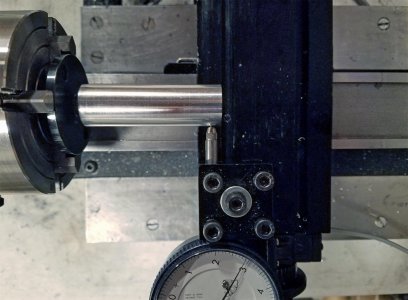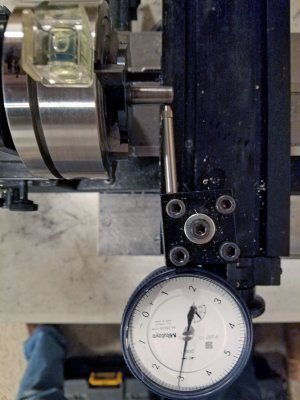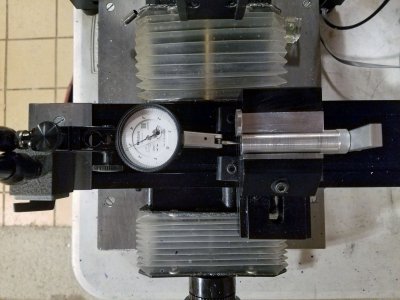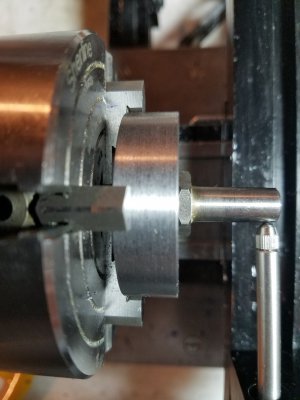I changed my mind. I decided to make a spindle out of 6061-T6 aluminum,
without offsetting the Morse-taper socket from the centerline. Making spindle with an offset Morse-taper socket seemed like too big of a leap in developing the procedure. Also, having one without an offset that fits tighter in the tailstock will allow me to measure with less uncertainty the misalignment of the tailstock.
In terms of lathe work, I model the spindle as being 2.375 inches long, with an O-size (0.312-inch diameter) hole drilled 1.875 inches deep down the centerline from one side. A Morse #0 socket begins at 0.350 inch diameter and tapers down to the diameter of the O-size hole. On the centerline of the other side, a 1/4-20 left-hand thread is drilled and tapped to meet the O-size hole.
I started with a piece of 3/4-inch OD 6061-T6 aluminum bar stock, which I cut and faced to 2.375 inches long. This was the workpiece.
I mounted the workpiece in the Sherline 3-jaw self-centering chuck (#1040). I bump-centered the unmounted end. I drilled 1.875 inches deep with an O-size drill. I used a Sherline 3/8"-capacity drill chuck (#1069) and a Sherline Adjustable Trailstock Chuck Holder (#1202). To drill so deep, I drilled in two steps: 1 inch and 0.875 inch. I moved the tailstock to the left by 1 inch after drilling 1 inch. I had set the crosslide as a location reference, for moving the tailstock 1 inch.
After drilling the hole, I removed the chuck from the lathe, with the workpiece still mounted in the chuck. A Morse #0 socket was later bored in the drilled side.
I installed a Sherline four-jaw independent chuck on the lathe. I mounted a Sherline Adjustable Tool Back (#12040) from one of my Sherline adjustable tailstock tools. The Adjustable Tool Back has a Morse #0 shank, which I later used to set the angle of the Sherline Compound Slide (#1270), and which I used to hold the workpiece when I turned down the workpiece OD to fit the tailstock.
I set the Adjustable Tool Back in the chuck with a 1-inch x 4-inch x 0.010 inch brass shim against the body of the chuck. I pulled the shim out, to create space for movement during tapping in. Here is a photo of the Adjustable Tool Back in the chuck, before pulling out the shim.
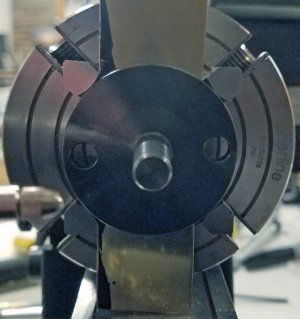
I used a dial-test indicator, mounted on the cross slide to measure the runout of the shank - near the base of the shank and near its end. I adjusted the screws of the chuck to eliminate runout near the base of the shank. I tapped the disk toward the chuck to eliminate runout at the end of the shank. I achieved 0.0001 inch TIR near the base and end of the shank. I then measured the amount of taper of the shank in the x-axis along 0.600 inches of the z-axis at the #1, #2, #3, and #4 chuck screw locations on the circumference. Here are the values, respectively: 0.01541, 0.01542, and 0.01541, and 0.01540 inch. Similar values suggest that the shank is nearly parallel to the z-axis.
I set the angle of the compound slide against the Morse shank. Here is a photo, taken looking down:
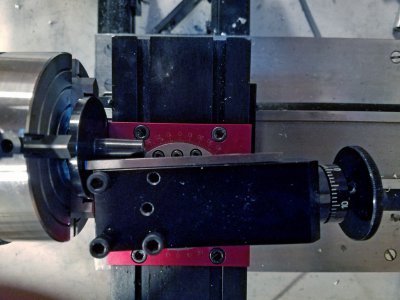
In the photo, there is a 1-inch wide parallel between the compound slide and the Morse shank. The mounting and adjustment screws of the compound slide were loose. I tightened them while pressing the compound slide, parallel, and shank together.
I removed the 4-jaw chuck and Morse shank from the lathe. I used then again, later.
I remounted the 3-jaw chuck and workpiece on the lathe. I used the Sherline High Speed Steel Boring Tool (#11970) to bore the Morse socket. I bored it at 600 rpm with feed rate of 0.5 handwheel rotations per second. I advanced the crosslide to the rear a total of 0.019 inches ((0.350 inch - 0.312 inch)/2 = 0.019 inch). Here is a photo taken looking down:
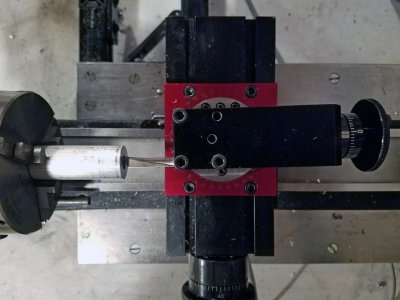
In hindsight, I think it would have been better to have turned the OD of the workpiece smooth at the beginning, and used the Sherline Steady Rest (#1074) to support the workpiece during the boring operation.
I removed the workpiece from the 3-jaw chuck. I reinstalled the 4-jaw chuck with its Morse shank, and twisted the workpiece onto the Morse shank. I installed my extended-length dead center, and proceeded to turn down the OD of the workpiece to fit the ID (0.6192 inch) of the Tailstock Case. Here is a photo:
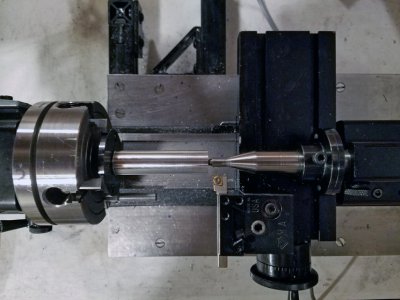
The cutting tool is a Micro 100 CCMT 2-1.5-1 carbide insert in a Micro 100 tool holder (#10-3231). Cutting conditions were 600 rpm, one handwheel rotation per second, and depth-of-cuts of 0.005, 0.001, and 00005 inch. Toward the end of turning down, though, I replaced the cutting tool with a brazed carbide Micro 100 AR4 turning tool. The set up was not sufficiently rigid for the carbide insert. The workpiece was tapering 0.0004 inch larger in diameter from left to right, even with 0.0005 inch depth-of-cut and multiple spring passes with the insert. I think that the brazed carbide tool did better because it was sharper. In the end, the diameter was 0.6187 inch left, 0.6187 inch middle. and 0.6188 inch right. My goal was 0.6188 inch. The ID of the tailstock is 0.6192 inch.
Finally, I drilled and cut 1/4-20 left-hand threads in the right end of the workpiece. Toward the end of cutting the threads with a tap, the workpiece slipped on the Morse shank. I removed the workpiece from the Morse shank, wrapped it with paper masking tape for a hand grip, and finished the threads by hand.
I installed the workpiece in the trailstock, as an unfinished spindle. The fit is good. There seems to be room for tighter. Perhaps I will aim for 0.6189 inch diameter next time.
I measured the misalignment of the tailstock as before, with the unfinished spindle at four 90-degree rotations around the z-axis. The horizontal misalignment readings were 0.00238, 0.00252, 0.00247, and 0.00232 inch toward the rear. The vertical misalignment readings were 0.00078, 0.00092, 0.00108, and 0.00090 inch high. The average values are 0.00242 and 0.00092 inches. Those values are with the tailstock screw lose. Tightening the tailstock screw increased the horizontal misalignment by 0.00030 inch; it increased the vertical misalignment by 0.00008 inch.
The traverse along the 5.96-inch long test bar was 4.40 inches. Accounting for the difference increases the misaligment values to 0.00328 inch to the rear and 0.00125 inch high.
I will finish the spindle, by milling a slot in the side.
Karl






